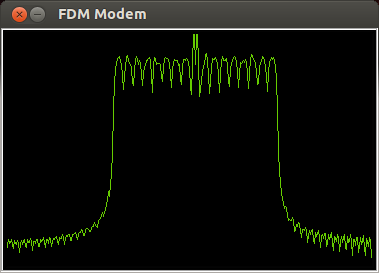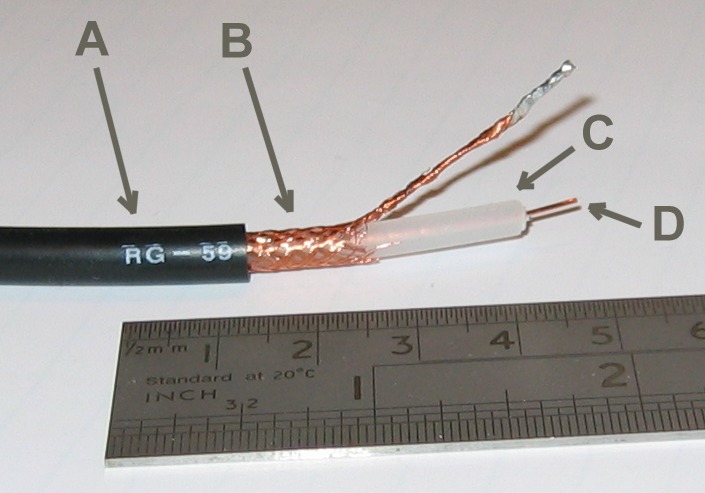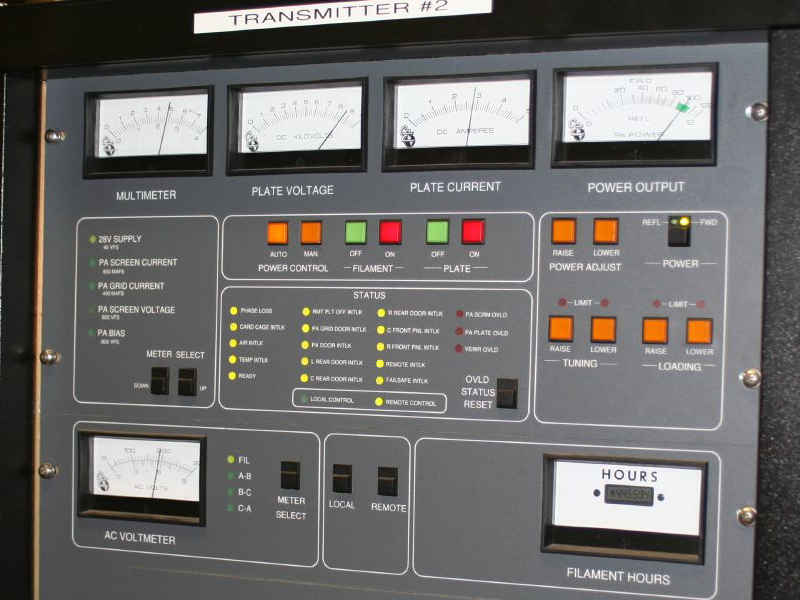|
Frequency-division Multiplexing
In telecommunications, frequency-division multiplexing (FDM) is a technique by which the total bandwidth (signal processing), bandwidth available in a communication channel, communication medium is divided into a series of non-overlapping frequency bands, each of which is used to carry a separate signal. This allows a single transmission medium such as a microwave radio link, cable or optical fiber to be shared by multiple independent signals. Another use is to carry separate serial bits or segments of a higher rate signal in Parallel communication, parallel. The most common example of frequency-division multiplexing is radio and television broadcasting, in which multiple radio signals at different frequencies pass through the air at the same time. Another example is cable television, in which many television channels are carried simultaneously on a single cable. FDM is also used by telephone systems to transmit multiple telephone calls through high capacity trunklines, communi ... [...More Info...] [...Related Items...] OR: [Wikipedia] [Google] [Baidu] [Amazon] |
Telecommunications
Telecommunication, often used in its plural form or abbreviated as telecom, is the transmission of information over a distance using electronic means, typically through cables, radio waves, or other communication technologies. These means of transmission may be divided into communication channels for multiplexing, allowing for a single medium to transmit several concurrent Session (computer science), communication sessions. Long-distance technologies invented during the 20th and 21st centuries generally use electric power, and include the electrical telegraph, telegraph, telephone, television, and radio. Early telecommunication networks used metal wires as the medium for transmitting signals. These networks were used for telegraphy and telephony for many decades. In the first decade of the 20th century, a revolution in wireless communication began with breakthroughs including those made in radio communications by Guglielmo Marconi, who won the 1909 Nobel Prize in Physics. Othe ... [...More Info...] [...Related Items...] OR: [Wikipedia] [Google] [Baidu] [Amazon] |
Carrier Signal
In telecommunications, a carrier wave, carrier signal, or just carrier, is a periodic waveform (usually sinusoidal) that conveys information through a process called ''modulation''. One or more of the wave's properties, such as amplitude or frequency, are modified by an information bearing signal, called the ''message signal'' or ''modulation signal''. The carrier frequency is usually much higher than the message signal frequency; this is because it is usually impractical to transmit signals with low frequencies over long distances (due to attenuation). The purpose of the carrier is usually either to transmit the information through space as an electromagnetic wave (as in radio communication), or to allow several carriers at different frequencies to share a common physical transmission medium by frequency division multiplexing (as in a cable television system). The term originated in radio communication, where the carrier wave creates the waves which carry the information (modul ... [...More Info...] [...Related Items...] OR: [Wikipedia] [Google] [Baidu] [Amazon] |
Demodulation
Demodulation is the process of extracting the original information-bearing signal from a carrier wave. A demodulator is an electronic circuit (or computer program in a software-defined radio) that is used to recover the information content from the modulated carrier wave. There are many types of modulation, and there are many types of demodulators. The signal output from a demodulator may represent sound (an analog audio signal), images (an analog video signal) or binary data (a digital signal). These terms are traditionally used in connection with radio receivers, but many other systems use many kinds of demodulators. For example, in a modem, which is a contraction of the terms modulator/demodulator, a demodulator is used to extract a serial digital data stream from a carrier signal which is used to carry it through a telephone line, coaxial cable, or optical fiber. History Demodulation was first used in radio receivers. In the wireless telegraphy radio systems us ... [...More Info...] [...Related Items...] OR: [Wikipedia] [Google] [Baidu] [Amazon] |
Local Oscillator
In electronics, the term local oscillator (LO) refers to an electronic oscillator when used in conjunction with a Frequency mixer, mixer to change the frequency of a signal. This frequency conversion process, also called Heterodyne, heterodyning, produces the sum and difference frequencies from the frequency of the local oscillator and frequency of the input signal. Processing a signal at a fixed frequency gives a radio receiver improved performance. In many receivers, the function of local oscillator and mixer is combined in one stage called a "Pentagrid converter, converter" - this reduces the space, cost, and power consumption by combining both functions into one active device. The term ''local'' refers to the fact that the frequency is generated within the circuit and is not reliant on any external signals, although the frequency of the oscillator may be tuned according to external signals. Applications Local oscillators are used in the superheterodyne receiver, the most c ... [...More Info...] [...Related Items...] OR: [Wikipedia] [Google] [Baidu] [Amazon] |
Digital Cable
Digital cable is the distribution of cable television using digital data and video compression. The technology was first developed by General Instrument. By 2000, most cable companies offered digital features, eventually replacing their previous analog-based cable by the mid 2010s. During the late 2000s, broadcast television converted to the digital HDTV standard, which was incompatible with existing analog cable systems. In addition to providing high-definition video, digital cable systems provide more services such as pay-per-view programming, cable internet access and cable telephone services. Most digital cable signals are encrypted, which reduced the incidence of cable television piracy which occurred in analog systems. History In 1990, General Instrument (acquired by Motorola and now owned by ARRIS Group) demonstrated that it was possible to use digital compression to deliver high quality HDTV in a standard 6 MHz television channel. Using the same technology G ... [...More Info...] [...Related Items...] OR: [Wikipedia] [Google] [Baidu] [Amazon] |
Coaxial Cable
Coaxial cable, or coax (pronounced ), is a type of electrical cable consisting of an inner Electrical conductor, conductor surrounded by a concentric conducting Electromagnetic shielding, shield, with the two separated by a dielectric (Insulator (electricity), insulating material); many coaxial cables also have a protective outer sheath or jacket. The term ''coaxial'' refers to the inner conductor and the outer shield sharing a geometric axis. Coaxial cable is a type of transmission line, used to carry high-frequency Signal, electrical signals with low losses. It is used in such applications as telephone trunk lines, Internet access, broadband internet networking cables, high-speed computer bus (computing), data buses, cable television signals, and connecting Transmitter, radio transmitters and Radio receiver, receivers to their Antenna (radio), antennas. It differs from other shielded cables because the dimensions of the cable and connectors are controlled to give a precise, ... [...More Info...] [...Related Items...] OR: [Wikipedia] [Google] [Baidu] [Amazon] |
Radio Transmitter
In electronics and telecommunications, a radio transmitter or just transmitter (often abbreviated as XMTR or TX in technical documents) is an electronic device which produces radio waves with an antenna with the purpose of signal transmission to a radio receiver. The transmitter itself generates a radio frequency alternating current, which is applied to the antenna. When excited by this alternating current, the antenna radiates radio waves. Transmitters are necessary component parts of all electronic devices that communicate by radio, such as radio (audio) and television broadcasting stations, cell phones, walkie-talkies, wireless computer networks, Bluetooth enabled devices, garage door openers, two-way radios in aircraft, ships, spacecraft, radar sets and navigational beacons. The term ''transmitter'' is usually limited to equipment that generates radio waves for communication purposes; or radiolocation, such as radar and navigational transmitters. Generators of radio ... [...More Info...] [...Related Items...] OR: [Wikipedia] [Google] [Baidu] [Amazon] |
Passband
A passband is the range of frequency, frequencies or wavelengths that can pass through a Filter (signal processing), filter. For example, a radio receiver contains a bandpass filter to select the frequency of the desired radio signal out of all the radio waves picked up by its antenna. The passband of a receiver is the range of frequencies it can receive when it is tuned into the desired frequency as in a radio station or television channel. A band-pass filter, bandpass-filtered signal (that is, a signal with energy only in a passband), is known as a bandpass signal, in contrast to a baseband signal. The bandpass filter usually has two stopband, band-stop filters. Filters In telecommunications, optics, and acoustics, a passband (a band-pass filtered signal) is the portion of the frequency spectrum that is transmitted (with minimum relative loss or maximum relative Gain (electronics), gain) by some filtering device. In other words, it is a ''band'' of frequencies which ''pa ... [...More Info...] [...Related Items...] OR: [Wikipedia] [Google] [Baidu] [Amazon] |
Sideband
In radio communications, a sideband is a band of frequencies higher than or lower than the carrier frequency, that are the result of the modulation process. The sidebands carry the information transmitted by the radio signal. The sidebands comprise all the spectral components of the modulated signal except the carrier. The signal components above the carrier frequency constitute the upper sideband (USB), and those below the carrier frequency constitute the lower sideband (LSB). All forms of modulation produce sidebands. Sideband creation We can illustrate the creation of sidebands with one trigonometric identity: :\cos(A)\cdot \cos(B) \equiv \tfrac\cos(A+B) + \tfrac\cos(A-B) Adding \cos(A) to both sides: :\cos(A)\cdot +\cos(B)= \tfrac\cos(A+B) + \cos(A) + \tfrac\cos(A-B) Substituting (for instance) A \triangleq 1000\cdot t and B \triangleq 100\cdot t, where t represents time: :\underbrace_\cdot \underbrace_ = \underbrace_ + \underbrace_ + \un ... [...More Info...] [...Related Items...] OR: [Wikipedia] [Google] [Baidu] [Amazon] |
Carrier Frequency
In telecommunications, a carrier wave, carrier signal, or just carrier, is a periodic waveform (usually sinusoidal) that conveys information through a process called ''modulation''. One or more of the wave's properties, such as amplitude or frequency, are modified by an information bearing signal, called the ''message signal'' or ''modulation signal''. The carrier frequency is usually much higher than the message signal frequency; this is because it is usually impractical to transmit signals with low frequencies over long distances (due to attenuation). The purpose of the carrier is usually either to transmit the information through space as an electromagnetic wave (as in radio communication), or to allow several carriers at different frequencies to share a common physical transmission medium by frequency division multiplexing (as in a cable television system). The term originated in radio communication, where the carrier wave creates the waves which carry the information (mo ... [...More Info...] [...Related Items...] OR: [Wikipedia] [Google] [Baidu] [Amazon] |
Modulation
Signal modulation is the process of varying one or more properties of a periodic waveform in electronics and telecommunication for the purpose of transmitting information. The process encodes information in form of the modulation or message signal onto a carrier signal to be transmitted. For example, the message signal might be an audio signal representing sound from a microphone, a video signal representing moving images from a video camera, or a digital signal representing a sequence of binary digits, a bitstream from a computer. This carrier wave usually has a much higher frequency than the message signal does. This is because it is impractical to transmit signals with low frequencies. Generally, receiving a radio wave requires a radio antenna with a length that is one-fourth of the wavelength of the transmitted wave. For low frequency radio waves, wavelength is on the scale of kilometers and building such a large antenna is not practical. Another purpose of modulation ... [...More Info...] [...Related Items...] OR: [Wikipedia] [Google] [Baidu] [Amazon] |
Piggybacking (data Transmission)
Piggyback, piggy-back, or piggybacking may mean: Transport * Piggyback (transportation), something that is riding on the back of something else Art, entertainment, and media *Splash cymbal piggybacking, mounting a cymbal on top of an already stand-mounted cymbal *Piggyback (song), "Piggyback" (song), 2017 song by Melanie Martinez *Chapter Nine: The Piggyback, 2022 episode of ''Stranger Things''. Business, finance, and law * Piggy-back (law), shareholder selling rights * Piggybacking, a practice in which a person with bad credit uses the seasoned tradeline of credit of someone else Electronics * Piggyback board, a daughterboard * Piggyback microcontroller, a microcontroller variant with EPROM socket Healthcare * Piggybacking, a second infusion set onto the same intravenous line using a Y-Set (intravenous therapy) * "Liver transplantation#Technique, Piggy-back technique", is a technique in liver transplantation in which the recipient inferior vena cava is preserved. * Visio ... [...More Info...] [...Related Items...] OR: [Wikipedia] [Google] [Baidu] [Amazon] |




